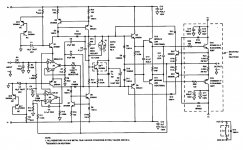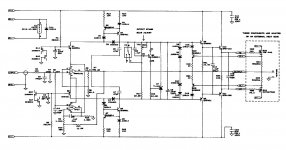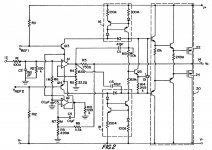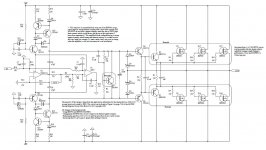Why does this readership not exclusively use class A power amplifiers? This is one of those questions that is so basic that I’m almost too scared to ask.
Some ground rules for this question:-
I’m only considering this specific readership, i.e. audiophiles
I’m including DIY amplifiers
Exclude battery powered equipment
Exclude micro power devices
Exclude devices regulated by energy saving legislation
The textbook reason for overlooking class A is efficiency. It may only be 30%. A class D type may be say 95%. The difference is 65%. For a decent amp of 100W, the difference is clearly 65W. That is the equivalent of a common bulb that you have in your toilet. When listening to your favourite ABBA tracks, you might put on more mood lighting than that. A high end amplifier might cost £3000, and some individual valves retail at £100/pair. Considering the economic demographic group that audiophiles belong to, I cannot accept that electricity consumption /component cost is a factor in amplifier class selection.
I’ve recently been reading a very good book on human psychology in order to explain why I do all the stupid stuff I do. Apparently, as a social species, we do as we are told. The marketing people tell us that AB then D type amplifiers are more efficient, therefore better. The best is of course class T which would substantially differentiate that supplier from the mundane others. “Always seek the more complex” seems to be the direction of travel.
Why then exclude As? Are people slaves to the marketeers? If you’re comfortably off, accept the extra consumption and love the simplicity of class A. Why ever not..?
Some ground rules for this question:-
I’m only considering this specific readership, i.e. audiophiles
I’m including DIY amplifiers
Exclude battery powered equipment
Exclude micro power devices
Exclude devices regulated by energy saving legislation
The textbook reason for overlooking class A is efficiency. It may only be 30%. A class D type may be say 95%. The difference is 65%. For a decent amp of 100W, the difference is clearly 65W. That is the equivalent of a common bulb that you have in your toilet. When listening to your favourite ABBA tracks, you might put on more mood lighting than that. A high end amplifier might cost £3000, and some individual valves retail at £100/pair. Considering the economic demographic group that audiophiles belong to, I cannot accept that electricity consumption /component cost is a factor in amplifier class selection.
I’ve recently been reading a very good book on human psychology in order to explain why I do all the stupid stuff I do. Apparently, as a social species, we do as we are told. The marketing people tell us that AB then D type amplifiers are more efficient, therefore better. The best is of course class T which would substantially differentiate that supplier from the mundane others. “Always seek the more complex” seems to be the direction of travel.
Why then exclude As? Are people slaves to the marketeers? If you’re comfortably off, accept the extra consumption and love the simplicity of class A. Why ever not..?
What am I missing?
Nothing at all. An amplifier might draw 100W at the wall socket. A class A will output 30W max. to the speakers. A class D, 95W. The difference is a light bulb load. Saving the planet and CO2 emissions cannot be the true reason for choosing the class D, especially with all the complications and distortions.
Why not compare apples to apples in terms of power output? ClassD lovers tend to like high power amps, at least 200W per channel. There are plenty of classD amps that go beyond that - nCore is jolly popular and that's about 400W.
Do the math for a classA stereo amp rated at 400W RMS.per channel.
Do the math for a classA stereo amp rated at 400W RMS.per channel.
There is Huge application for low energy consumption / high output amplifiers where everything after the last .01% simply will not be heard no matter what else you do, especially in today's bluetooth/ battery world. It's also a real challenge to design a class D circuit that could compete with class A.
Do the math for a classA stereo amp rated at 400W RMS.per channel.
Like this? My girlfriend's AEG electric oven is rated at 3240W which is 8 times the power of your amplifier. She bakes for hours at a time, and I think that she must have a reinforced electricity meter. I estimate a power consumption of 1300W for 400W of class A power delivered to a speaker.
Would a well off AB (socio-economic class not amplifier class) professional select a class D amplifier because it saves 880W of power? And what percentage of readers here have 400W amplifiers? This is the crux of my question. If yes, then I'm prepared to accept that
Your questioning presupposes that there is a tradeoff of efficiency vs quality of reproduction
That was the driving force behind my question. Isn't the relationship inversely proportional though? A (best quality / least efficiency) compared to D (lower quality / most efficient). Seems like another reason for class As.
I'm not pushing either, just trying to get to the bottom of the choices people make...
class A is efficiency. It may only be 30%. A class D type may be say 95%. The difference is 65%.
Umm. No.
A class A amplifier might have as much as 50% efficiency at maximum power, though typically probably the 30% figure is closer. Probably quite a bit less for many single ended class A amplifiers (particulary if they have filaments to keep hot, too). A 100W class A amplifier like the 30% example would suck about 333W (100/0.3) from its power supply at maximum power. But no one operates their amplifier at continuous maximum power.
The problem is that the class A amplifier would still draw about 165W, or more (a single ended class A amp, if it doesn't use a gapped inductor would draw the same 333W still!), from the wall even when its output power is close to zero. And that condition that is MUCH closer to the one that it will spend its powered-up life at -- expect maybe a watt output average, depending on speaker efficiency, of course. The 100W situation would happen only briefly at a peak.
The 100W class D amp? It will take 106W (100/0.95) from the electric socket under the maximum output condition, which is in fact 222W less than the class A amplifier under that (quite irrelevant) condition. At the much more likely near zero output power, though, it will likely dissipate maybe 5W. Class D keeps higher efficiency at lower power outputs, class A is most efficient near maximum. So, during typical use, the difference is about 160Watts. So, that's 2.5x 60W bulbs burning away. Double that for stereo, of course.
Not to mention the extra power that might be needed in summer time in warmer climes to get that heat out of the listening room (in winter you might be able to use some of the waste heat, though). And of course the efficiency we are talking about is only from the power supply, AFTER it has already changed the AC line juice to DC, and that also has an associated efficiency and power loss, so the difference grows. If the supply is regulated or has big filter inductors, more still. And if power factors get into it... on up it increases even more. Before long the difference in power starts to look like that of a small space heater.
(I design and use class A power amplifiers in one of my systems, btw. But I harbor no illusions about the side effects of using them!)
Last edited:
You seem to be stuck on the use of electricity as the factor in efficiency. In a guitar amp anyway, we are not concerned over the utility bill. However, for any given amount of output, the larger we have to make the power supply, the more the thing will cost. it will need larger power transformers, larger other parts.
In a guitar amp, fidelity is not the goal. In a hifi, the whole point is to make it amplify exactly. To faithfully reproduce the input. In a guitar amp, the amplifier is a fundamental part of sound production - it is PART of the instrument. That is why some players like a Fender amp and others like a MArshall, each has its own sound. Any guitarist who ever played his guitar directly through a hifi system will tell you it sounds lifeless. A guitar amp is SUPPOSED to color the sound and add its own character.
When it comes to class A or AB in a tube amp, it is more about the dynamics and overall sound than it is about efficiency. Some amps that are more or less class A circuits, like old Vox amps, were known as tube eaters. Tubes wear out more quickly than in other amps. This can be an issue while touring especially.
Class D is more about higher power amps. Nowdays there are even low power class D guitar amps, but where it mainly shines is something like a bass amp. I can get more power from my amp with an efficient class D amplifier for a given amount of mains current. On stage, many times available mains power is a limiting factor. If I have only 4000 watts available on stage, I'd rather have 95% of it available as sound than 30% of it. But I also would prefer not to have to haul around a 100 pound amplifier. I think the Peavey Classic 400 head weighed 105 pounds, the very popular Ampeg SVT 300 watt head weighed 85 pounds. Modern digital amps with SMPS can crank out 1500 watts and weigh only seven pounds.
In a guitar amp, fidelity is not the goal. In a hifi, the whole point is to make it amplify exactly. To faithfully reproduce the input. In a guitar amp, the amplifier is a fundamental part of sound production - it is PART of the instrument. That is why some players like a Fender amp and others like a MArshall, each has its own sound. Any guitarist who ever played his guitar directly through a hifi system will tell you it sounds lifeless. A guitar amp is SUPPOSED to color the sound and add its own character.
When it comes to class A or AB in a tube amp, it is more about the dynamics and overall sound than it is about efficiency. Some amps that are more or less class A circuits, like old Vox amps, were known as tube eaters. Tubes wear out more quickly than in other amps. This can be an issue while touring especially.
Class D is more about higher power amps. Nowdays there are even low power class D guitar amps, but where it mainly shines is something like a bass amp. I can get more power from my amp with an efficient class D amplifier for a given amount of mains current. On stage, many times available mains power is a limiting factor. If I have only 4000 watts available on stage, I'd rather have 95% of it available as sound than 30% of it. But I also would prefer not to have to haul around a 100 pound amplifier. I think the Peavey Classic 400 head weighed 105 pounds, the very popular Ampeg SVT 300 watt head weighed 85 pounds. Modern digital amps with SMPS can crank out 1500 watts and weigh only seven pounds.
Class D is more about higher power amps.
My only and one encountering with those beasts
and similar gadgets where the ~4V battery allows for using them only.
So the thing is much broader than we can see
But...ehy ! I was thinking that I've always been using classic AB amps,
some advertized to work in class A in the First Watt...
nice, eh ?
Exclude devices regulated by energy saving legislation
I'm curious, I've never heard of this.
How about this reason - chassis size and weight. The need for large transformers.
No it isn't. 100W Class D amp takes 105W DC input; fed from a 95% efficient SMPS this takes 111W from the AC supply. 100W Class A amp takes 200W minimum, more like 250W DC; fed from an 80% efficient linear supply this takes 313W from the AC supply.Paul Uszak said:The textbook reason for overlooking class A is efficiency. It may only be 30%. A class D type may be say 95%. The difference is 65%. For a decent amp of 100W, the difference is clearly 65W.
In reality most valve amps at modest power levels (say, 30W) operate in Class A.
Solid-state amplifiers are different, as Class A needs huge heatsinks (or even fans for higher power). I suspect it is not cost or power consumption which puts people off Class A, but size and weight.
Excellent question indeed, and courageous. Try designing a 2 x 10 Watt amplifier operating in a sort of Class-A, having its quiescent current governed by the volume pot position.Why does this readership not exclusively use class A power amplifiers? This is one of those questions that is so basic that I’m almost too scared to ask.
Hooked on a pair of 87 dB SPL / 2.83 Vrms loudspeakers, it should dissipate less than 10 Watt when running for providing a moderate domestic listening level, say 80 dB SPL on your ears.
Mount a heatsink able to dissipate 60 Watt when the fan is on.
Design the heatsing in such a way that the fan can remain off when the amplifier is dissipating less than 10 Watt.
There are more and more diyAudio projects basing on prototyping boards featuring a microcontroller like the STM32F4 and STM32F7 Nucleo boards. Nowadays, it takes almost no money to rely on a simple remote control, and it takes almost no computing power to hook a 36 kHz infrared receiver for managing the listening volume. You can rely on a STM32 PWM output for generating a DC voltage that's proportional to the volume pot position.
You can rely on a LED+LDR combination (this is called a Vactrol) or an opto-coupler for emulating a variable resistor around the Vbe multiplier transistor that's governing the power amplifier bias current.
Some people will battle against this, saying that the variable quiescent current prevents optimizing the high frequency response (high frequency stability). Let them say. Don't argue.
In case you dislike building a power amplifier using discrete components, you may rely on a modern integrated circuit used as differential amp and voltage amp, followed by your preferred power transistors.
Search for "LM4702 Audio Amplifier Module" on eBay. You'll find plenty, some with bipolar output transistors, some with mosfet output transistors.
You may also hook your preferred audio opamp as differential cascode transconductance input stage, followed by a voltage amp using a pair of discrete transistors, followed by your preferred power transistors pair.
Such arrangement went public as soon as 1970 through the publication of the RCA µA777 application note.
Few people could understand the working principle because of the use of the opamp, as differential cascode transconductance input stage.
Still today, few people can understand the working principle, because the spice simulation of such arrangement requires a proper spice opamp model, what's regarding the opamp power supply pins.
It reappeared as "Kuroda amplifier" in 1983.
It reappeared as "Mark Alexander Current-Feedback Audio Power Amplifier" in 1990.
The US5097223 patent got issued to Mark Alexander in 1992.
It reappeared as "COLBY SSM-2131 Current Feedback Amp" in 1997.
See the attached .jpg files.
Regards,
Steph
Attachments
-
 1970 - Fairchild Databook 1 - The complete Linear book - µA777 application note.jpg84.3 KB · Views: 597
1970 - Fairchild Databook 1 - The complete Linear book - µA777 application note.jpg84.3 KB · Views: 597 -
 1983 - Kuroda Poweramp TL071.jpg36.5 KB · Views: 591
1983 - Kuroda Poweramp TL071.jpg36.5 KB · Views: 591 -
 1990 - AN-211 Analog Devices - The Alexander Current-Feedback Audio Power Amplifier.jpg231.8 KB · Views: 605
1990 - AN-211 Analog Devices - The Alexander Current-Feedback Audio Power Amplifier.jpg231.8 KB · Views: 605 -
 1990 - The Alexander Current-Feedback Power Amplifier - AES 88th Convention 1990.jpg201.4 KB · Views: 577
1990 - The Alexander Current-Feedback Power Amplifier - AES 88th Convention 1990.jpg201.4 KB · Views: 577 -
 1992 - The Alexander Current-Feedback Power Amplifier - US5097223 patent.jpg197 KB · Views: 569
1992 - The Alexander Current-Feedback Power Amplifier - US5097223 patent.jpg197 KB · Views: 569 -
 1997 - COLBY SSM-2131 Current Feedback Amp.jpg194.5 KB · Views: 353
1997 - COLBY SSM-2131 Current Feedback Amp.jpg194.5 KB · Views: 353
I've recently found the Pass Labs .8 series. Nice class A, marketed and sold as such. Peak 750W power consumption which is quite low for a luxury product. A Defender outputs about 91kW. There was no price but I expect around £5,000 - £10,000 which again seems reasonable. Not to bulky either, especially when compared to a high end turntable. I expect the component cost is a small part of the selling price, so if a DIYer is prepared to forgo finish for function, you should be able to put together a good class A less than £1000.
There are simple example circuits in the above post. I find it funny that they use the mundane children's 2N3904. Perhaps that is the USP of a class A. Simplicity and purity. Perhaps it's like the difference between a clever but common gas action semi-automatic vs. a quality revolver with a hand carved grip.
There are simple example circuits in the above post. I find it funny that they use the mundane children's 2N3904. Perhaps that is the USP of a class A. Simplicity and purity. Perhaps it's like the difference between a clever but common gas action semi-automatic vs. a quality revolver with a hand carved grip.
- Status
- This old topic is closed. If you want to reopen this topic, contact a moderator using the "Report Post" button.
- Home
- Member Areas
- The Lounge
- What is the real reason to avoid class A power amps?
